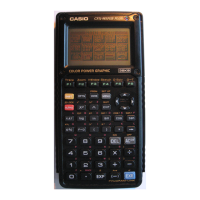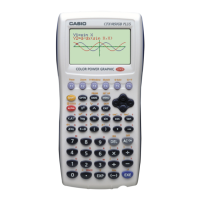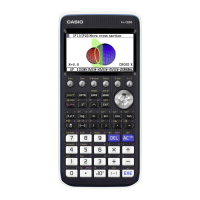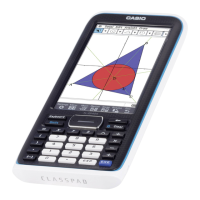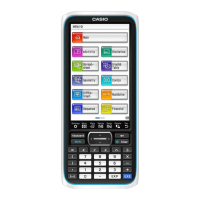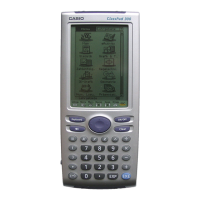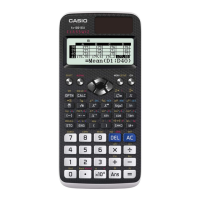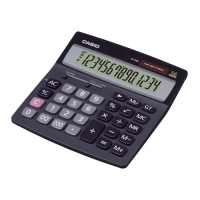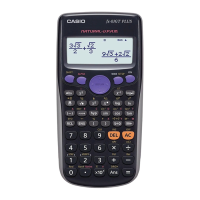
Do you have a question about the Casio CFX9850GBPLUS and is the answer not in the manual?
| Brand | Casio |
|---|---|
| Model | CFX9850GBPLUS |
| Category | Calculator |
| Language | English |
Introduces the calculator's keys and their primary functions.
Describes the different display modes, icons, and screen types.
Explains basic procedures for entering and modifying calculations, including using the clipboard.
Details the OPTN menu for accessing scientific functions not marked on the keyboard.
Explains how to recall and manage variable data, including V-Window and FACT settings.
Introduces the PRGM mode for creating, managing, and running programs.
Explains how to display and redisplay syntax information for commands.
Guides on changing mode settings, input modes, angle units, and display formats.
Details how to capture and save screen images.
Provides troubleshooting tips for common calculator issues like hangs and low battery.
Explains entering arithmetic calculations, operator priority, and handling negative values.
Introduces special functions like variable calculations, function memory, and answer memory.
Guides on setting angle units (Deg, Rad, Gra) and display formats (Fix, Sci, Norm, Eng).
Explains calculations using hyperbolic, probability, numeric, angle, and engineering functions.
Details methods for differential, integration, Σ, and Solve calculations.
Covers calculations involving complex numbers in rectangular and polar forms.
Explains calculations and conversions between different number systems.
Introduces matrix operations like addition, multiplication, inversion, and determinant.
Guides on inputting data one-by-one or in batches, and editing cell values.
Explains operations like transferring list contents to matrices, counting data items, and replacing data.
Details performing arithmetic calculations with lists and using list contents in calculations.
Guides on switching between different list files for data management.
Covers solving simultaneous linear equations with two to six unknowns.
Details solving quadratic and cubic equations by inputting coefficients.
Explains using the Solve Calculation mode to find variable values in formulas.
Provides troubleshooting tips for errors during equation calculations and clearing memories.
Explains how to draw simple graphs like y=3x², conic sections, and parametric functions.
Guides on setting V-Window parameters, zoom types, and line styles for graph display.
Details storing functions, specifying graph types, and drawing graphs.
Explains saving and recalling graph images to/from picture memory.
Guides on splitting the screen for Dual Graph, copying graphs, and graphing different functions.
Explains drawing graphs directly using commands, including integration graphs and multiple graphs.
Details storing functions, generating number tables using ranges or lists, and editing tables.
Explains how to observe graph changes by altering coefficient values and simulating phenomena.
Guides on generating number tables and graphing recursion formulas, including WEB graphs.
Explains changing line styles, inserting comments, freehand drawing, and graph backgrounds.
Details reading coordinates, displaying derivatives, calculating roots, intersections, and conic section properties.
Covers preliminary steps for statistical calculations, including inputting data into lists and changing graph parameters.
Details inputting and graphing single-variable data using plots like NPP, Histograms, Med-box, and Normal Distribution Curves.
Explains drawing scatter diagrams, xy line graphs, and various regression graphs (Linear, Med-Med, Quadratic, etc.).
Details how to perform single-variable, paired-variable, and regression calculations directly.
Introduces various statistical tests including Z Tests, t Tests, χ2 Tests, F Tests, and ANOVA.
Details calculating confidence intervals for population means and proportions using Z and t intervals.
Explains various probability distributions like Normal, Student-t, χ2, F, Binomial, Poisson, and Geometric.
Covers preliminary steps for financial calculations, including setup items and TVM mode graphing.
Details simple interest calculations using formulas and input screens.
Explains compound interest calculations using standard formulas and converting between nominal and effective rates.
Covers Net Present Value (NPV), Net Future Value (NFV), Internal Rate of Return (IRR), and Payback Period (PBP).
Details calculations for principal and interest portions of monthly installments.
Explains conversion between annual percentage rate (APR) and effective interest rate (EFF).
Covers calculations related to cost, selling price, and margin by inputting two values.
Explains calculations involving dates.
Covers fundamental steps for creating programs, including registering file names and inputting programs.
Introduces function keys used in PRGM mode for program creation and management.
Details debugging programs, eliminating bugs, and using existing programs to create new ones.
Explains searching for, editing, deleting, and registering passwords for program files.
Provides a reference for programming commands, including basic, program control, and display commands.
Guides on incorporating text display, matrix row operations, graph functions, and dynamic graph functions into programs.
A comprehensive list of commands available in PRGM mode across different levels.
Introduces pre-written programs like Prime Factorization and Sequence Differentiation.
Provides basic information about the Spreadsheet application screen, menus, and commands.
Covers operations for creating, opening, deleting, and saving spreadsheet files, and recalculating formulas.
Explains cell cursor movement, selecting cells, and navigating the spreadsheet screen.
Details inputting and editing cell data, including formulas, text, constants, and cell references.
Lists and explains S•SHT mode commands like CellIf, CellMin, CellMax, CellMean, CellMedian, CellSum, CellProd.
Guides on graphing statistical data from spreadsheets, including configuring graph parameters.
Details using the CALC function for statistical calculations on spreadsheet data.
Explains saving and recalling spreadsheet data to/from variables, List Memory, File Memory, and Mat Memory.
Provides a general introduction to eActivity, using the e•ACT mode, file operations, and workspace screen.
Guides on creating, opening, deleting, and searching for eActivity files.
Details inputting and editing text lines, math lines, stop lines, strips, and using copy/paste.
Explains how to call up and use Matrix Editor and List Editor within eActivities.
Guides on checking eActivity file and strip memory usage.
Introduces eActivity Guide for creating interactive tutorials with different operation patterns.
Guides on navigating and using the SYSTEM mode and its menu items.
Details settings for contrast adjustment and power properties (Auto Power Off, backlight).
Explains how to display version information for OS, add-ins, and user names.
Guides on resetting the calculator, including clearing different types of memory.
Guides on connecting two calculators using the connecting cable and specifying 3PIN type.
Details connecting the calculator to a computer via USB and setting cable type.
Explains data transfer operations (Send, Receive, Cable Type, Wakeup, Capture).
Lists important precautions for data communication, including error checks and data compatibility.
Guides on capturing calculator screen images and transferring them to a computer or OHP unit.
Explains installing add-in applications, language data, and upgrades using FA-124 software.
Introduces the MEMORY mode for managing main and storage memory, including creating folders and selecting data.

